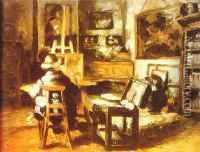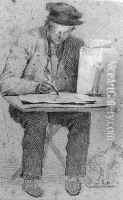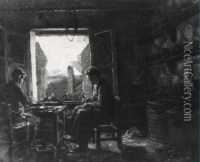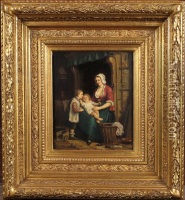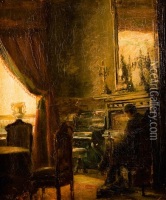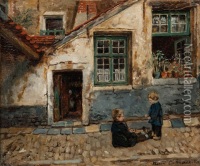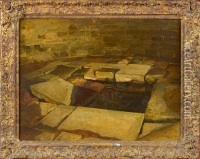Henri de Braekeleer Paintings
Henri de Braekeleer was a Belgian painter associated with the realist movement, born on July 28, 1840, in Antwerp. He was part of a family with a rich artistic heritage; his father, Ferdinand de Braekeleer the Elder, and his uncle, Ferdinand de Braekeleer the Younger, were both well-known artists of their time. This familial background provided Henri with a fertile environment for developing his artistic talents from a young age.
De Braekeleer's work is known for its meticulous attention to detail and its quiet, contemplative depiction of interiors and urban scenes. His compositions often featured the city of Antwerp, where he spent most of his life. In his early years, he was influenced by the Dutch masters of the 17th century, which is evident in his careful treatment of light and shadow, as well as his choice of domestic subjects.
Despite his considerable skill, de Braekeleer lived a life marked by financial hardship and struggled to gain widespread recognition during his lifetime. He remained relatively isolated from the larger art movements of the time, focusing instead on his personal, introspective approach to painting. His work did not fit neatly into the prevailing trends of Romanticism or the emerging Impressionist movement, which may have contributed to his lack of commercial success.
Henri de Braekeleer's paintings did, however, earn the admiration of fellow artists and critics. The influential Belgian art critic and poet Emile Verhaeren was a notable supporter of de Braekeleer's work. Additionally, the painter James Ensor, a major figure in Belgian art, expressed his admiration for de Braekeleer's ability to capture the essence of everyday life with honesty and sensitivity.
Henri de Braekeleer died relatively young, on January 29, 1888, in Antwerp. His legacy has grown posthumously, and today he is recognized for his contributions to realist painting. His works are held in several prestigious collections, including the Royal Museum of Fine Arts in Antwerp. De Braekeleer's dedication to the quiet moments of ordinary life has earned him a place among the notable European realists of the 19th century.
